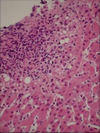Chronic Inflammation Flashcards
(37 cards)
What are the key characteristics of acute inflammation?
- Rapid response to any injury
- Macroscopic: redness, swelling, heat, pain and loss of function
- Microscopic: vascular dilatation, exudate into tissues and neutrophils emigrate
- Controlled by short-term chemical mediators
- Neutrophils
- fast acting
- short-lived phagocytes that engulf & degrade bacteria
- Phagocytosis by enhanced opsonisation
- Oxygen-dependent bacterial killing
- Defects in the system lead to sever susceptibility to infection
What is chronic inflammation?
“Chronic response to injury with associated fibrosis”
- Different timescale to acute response but the same effectors are used
- Overlaps with host immunity
- Heavily associated with fibrosis
What are the two routes to chronic inflammation?
- Acute insult -> Acute inflammation -> Severe damage -> Chronic inflammation
- Chronic insult -> Chronic inflammation
Both result in repair and fibrous scarring.
How does Chronic Inflammation arise?
- May follow from acute inflammation if damage is too severe to be resolved (most common)
- De novo
- from autoimmune conditions e.g. RA
- chronic infections e.g. viral hepatitis
- “chronic low-level irritation”
- Develops alongside acute inflammation e.g. ongoing bacteria infection
- in severe persistent or repeated inflammation
What does chronic inflammation look like?

Characterised microscopically which are much more variable than acute inflammation.
- Macrophages
- Lymphocytes
- Plasma cells
- Eosinophils
- Fibroblasts/ Myofibroblasts
- Giant Cells
- Langhans type giant cells (TB)
- Foreign body type giant cells
- Touton giant cell
What are macrophages?
- phagocytic cells with a bean-shaped nucleus and abundant cytoplasm
- derived from blood monocytes
- become macrophages when in tissue
- in acute and chronic inflammation

What are the functions of macrophages?
- Phagocytosis
- Antigen presentation
- Synthesis of:
- cytokines
- complement components
- blood clotting factors
- proteases
- Control of other cells by cytokine release
- Stimulating angiogenesis
- Inducing fibrosis
- Inducing fever, actue phase reaction and cachexia (wasting of the body)
What are lymphocytes?
- Predominat cells of the immune system
- Characterised into B and T lymphocyte s
- Presence in tissue they are normally absence in indicates that some antigenic material is or has been there

What are the functions of lymphocytes?
- Processing of antigens
- Secreting antibodies (carried out by differentiated B lymphocytes)
- Secreting of cytokines which influence other inflammatory cells
- Killing of cells (through natural killer cells attacking virus infected cells or tumour cells)
What are eosinophil and when are they normally found?
- Cells with a double lobed nucleus with red granules.
- Found scattered throughout the tissues
- Attack large parasites such as worms
- Present in high numbers in some immune responses:
- bronchi of asthmatics
- Hodgkins lymphoma

What are plasma cells and how are they revelant to the immune response?
- Differentiated antibody producing B lymphocytes.
- Confers chronic disease
- Produces imunoglobulins

What are fibroblast and myofibroblasts?
- Fibroblasts are the predifferentiated from of myofibroblasts
- Fibroblasts can response to chemotaxic stimuli and move to where they are needed
- produces collagen, elastin and glucosaminoglycans.
- Myofibroblast have the ability to contract in wound healing

What are giant cells?
- Macrophages fused together to produce larger cells
- caused by foreign bodies or infection with certain bacteria are present
- Large cells with dozens to hundreds of nuclei
- Seen in granulomatous inflammation

What are the three types of giant cell?
- Langhan’s Giant Cells
- Touton Giant Cells
- Foreign Body Giant Cells
Where are Langhans giant cells normally found?
- nuclei are arranged around the periphery of the giant cell
- normally seen in tuberculosis
- the immune system find the TB bacteria difficult to resolve

What do foreign body type giant cells look like and where are they normally found?
- nuclei are arranged randomly in the cell
- often seen when there is a hard to digest foreign body
- if the foreign body is small it can be phagocytosed by the giant cell and seen within it.
- if it is large the foreign body giant cell sticks to its surface

What do touton giant cells look like and where are they normally found?
- nuclei are arranged in a ring towards the centre of the cell
- form in lesions where there is a high lipid content such as fat necrosis and xanthomas
- due to fatty tissue being avascular, large marcophages are required to clean up dead fat tissue
- lesions also contain foam cells

What are foam cells?
Macrophages whos cytoplasm appears foamy from phagocyting a lot of lipid.
How can cell types in chronic inflammation aid the diagnosis?
Morphology of most chronic inflammatory reaction is non specfic but there are a few exceptions:
- Rheumatoid arthiritis: mainly plasma cells
- Chronic gastritis: mainly lymphocytes
- Leishmaniasis: mainly macrophages
Giant cells types also may be helpful to diagnose e.g. langhan ginat cell in TB
What are the effects of chronic inflammation?
- Fibrosis and Impaired function
- blocking off of ducts e.g. cholecystitis
- replaces normal parenchymal tissue e.g. intersitial fibrosis of the lung
- absorption in chronic inflammatory bowel disease
- Stimulation of immune response
- hayfever and rheumatoid arthiritis
What is chronic cholecystitis?
Repeated damage and pain of the gall bladder due to obstruction of gall stones.
- Repeated acute inflammation leads to chronic inflammation
- Gall bladder wall becomes fibrosed
What is inflammatory bowel diesase?
- Idiopathic inflammatory disease affecting the large and small bowl
- Pts present with diarrhoea and rectal bleeding
- Types include:
- Ulcerative colitis
- superficial, causes diarrhoea and bleeding
- Crohn’s disease
- transmural causing strictures and fistulae
- Ulcerative colitis
What are the common causes of liver cirrhosis?
- Alcohol
- Infection with HBV and HCV
- Imunnological
- Fatty liver disease
- Drugs and toxins

What is cirrhosis?
Scarring. Caused by chronic inflammation with fibrosis. Structural architecture is distrupted through attempted regneration.









